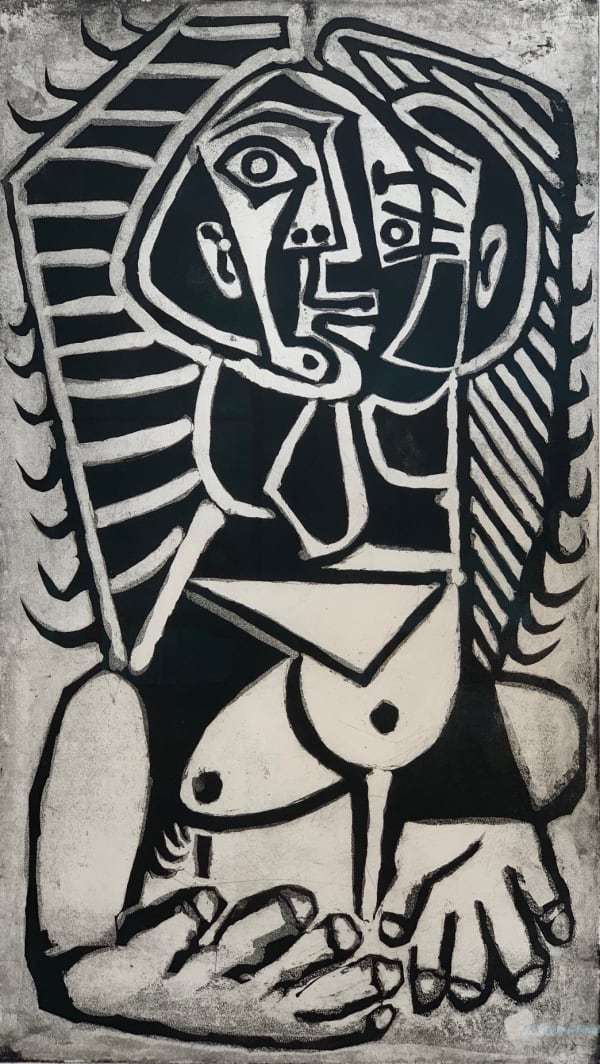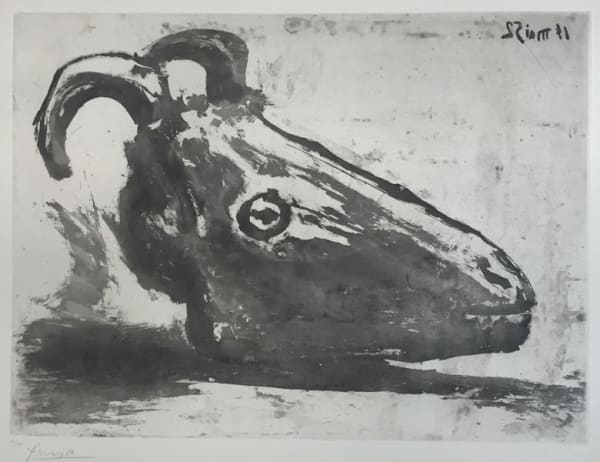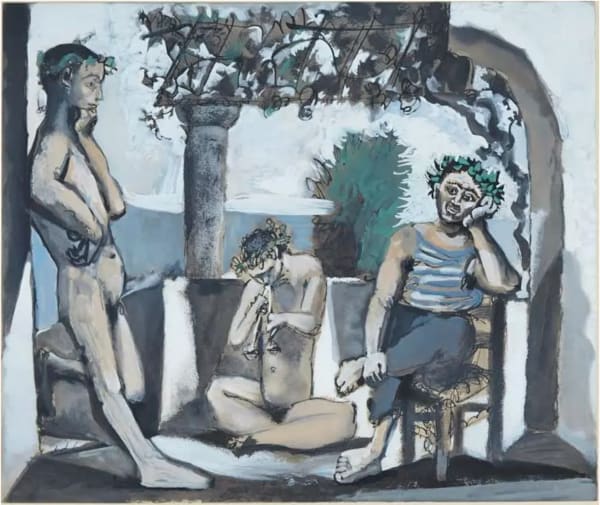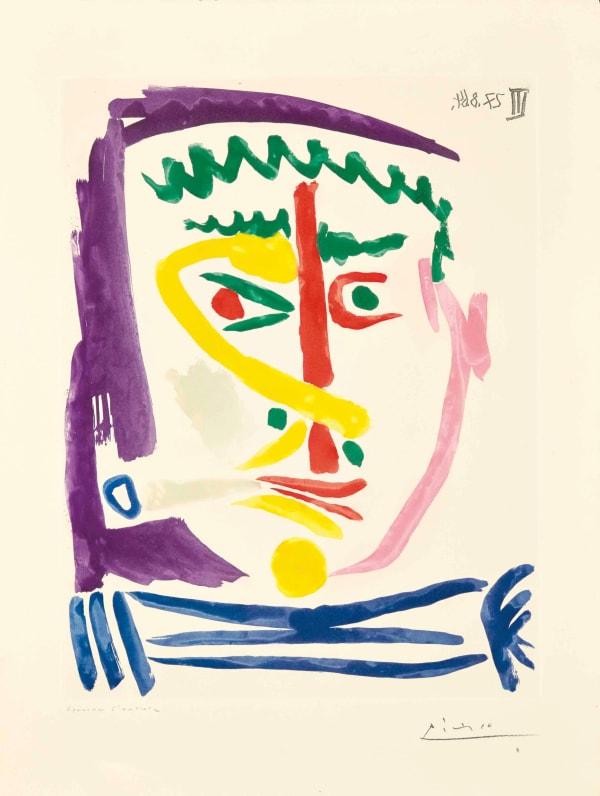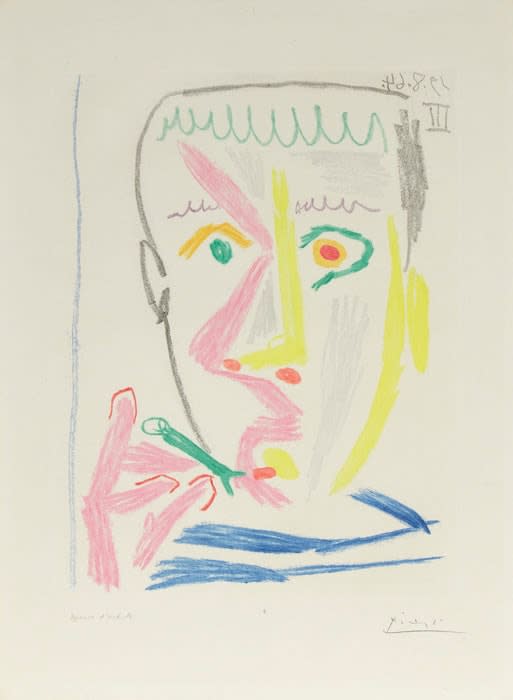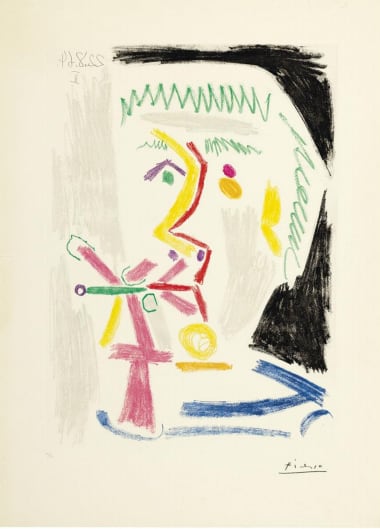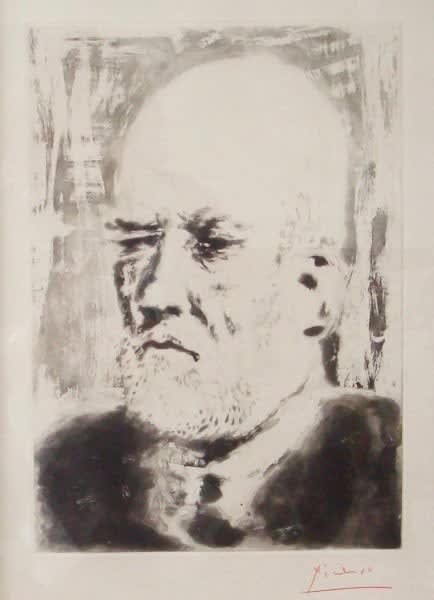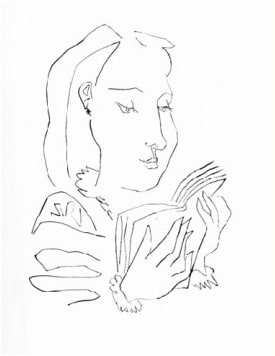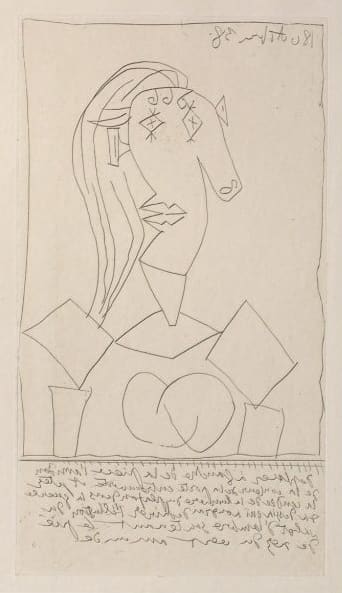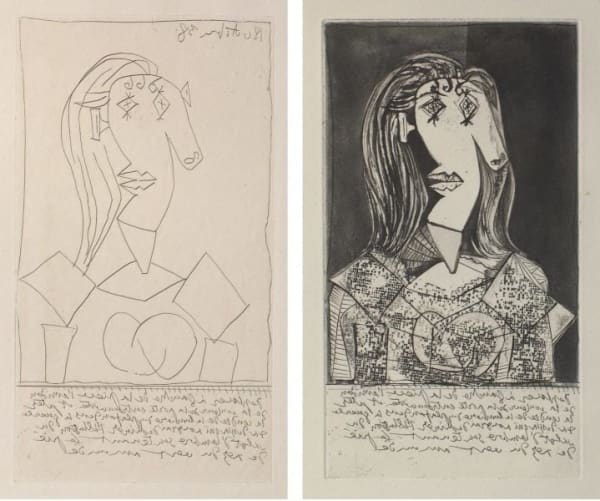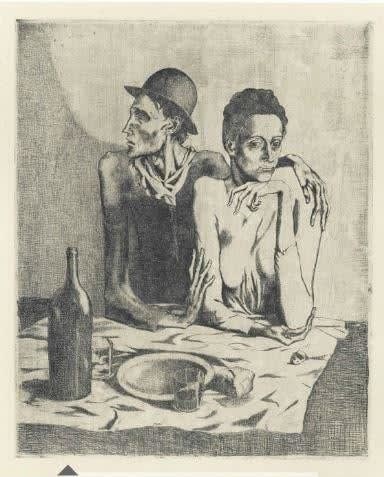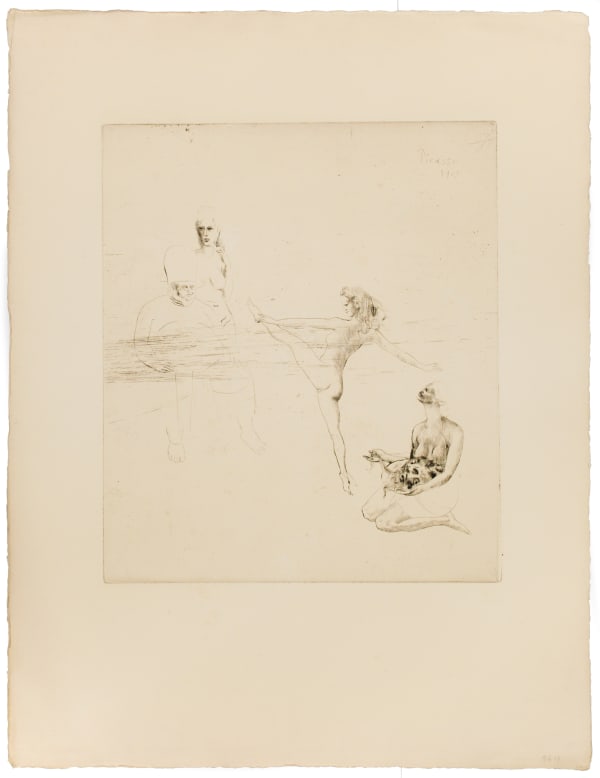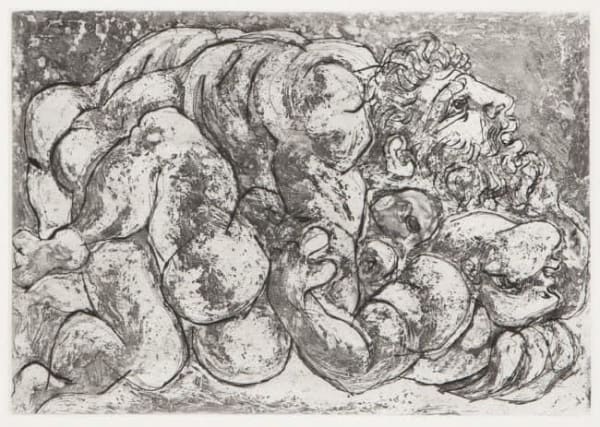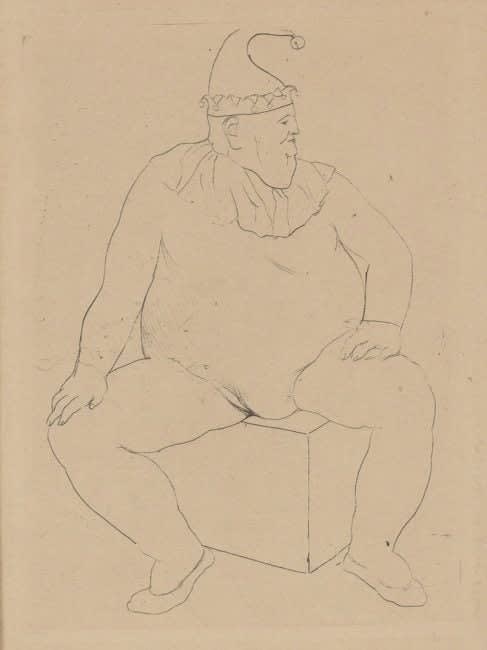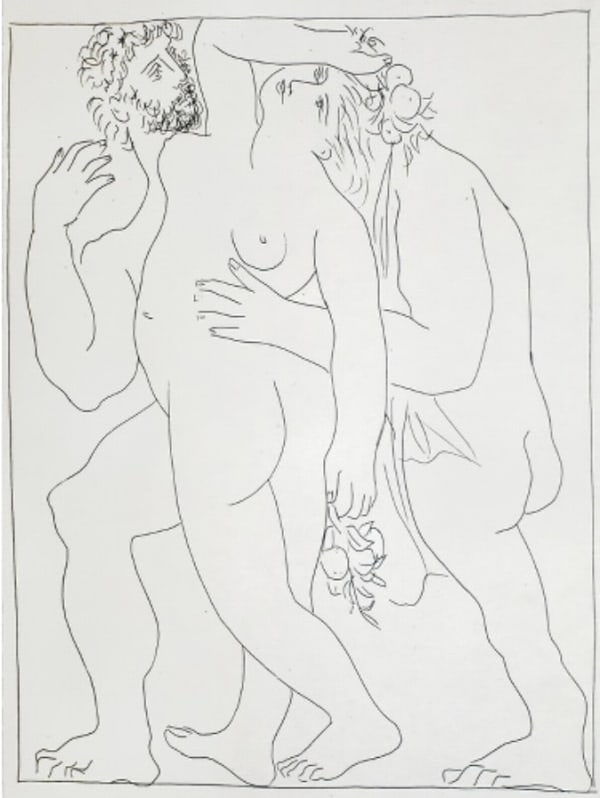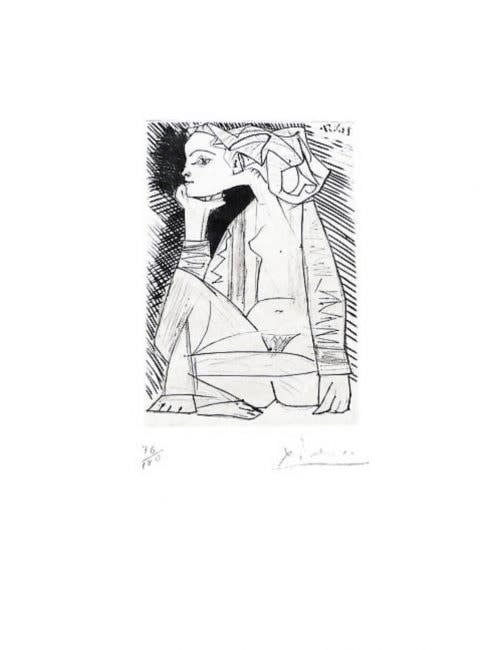
Pablo Picasso
67 x 55.5 cm
Ecce Homo—Latin for "Behold the Man"—is among the most complex and layered works in Picasso’s late graphic oeuvre. Created in 1970 when Picasso was 89 years old, this print combines drypoint, etching, and aquatint techniques to produce an image dense with symbolism, art historical reference, and a raw psychological charge. It reflects Picasso’s enduring fascination with myth, religion, sexuality, and the theatre of human experience—woven together here in a hallucinatory tableau that defies narrative clarity while insisting on emotional intensity.
At first glance, Ecce Homo appears to be a riot of faces, textures, and architectural elements. The composition is anchored by a large rectangular space at the center—perhaps a stage or painting within a painting—containing a group of nude and robed figures in a linear, almost classical drawing style. Surrounding this “scene” is a fevered mass of onlookers, grotesques, and mythic characters rendered with wild, expressive lines. The entire surface of the print vibrates with frenetic mark-making: hatched shadows, swirling textures, and layered impressions that evoke motion, tension, and collapse.
Picasso employs a diverse graphic language. The central scene is calmly rendered in precise etching, resembling a Renaissance or Neoclassical frieze. In contrast, the surrounding chaos is achieved through drypoint and aquatint—techniques that allow for rich blacks, erratic lines, and tonal smears. The upper portion is populated by spectral, carnival-like faces, some comic, some nightmarish. The lower section teems with overlapping heads and distorted figures that emerge and recede, as if under pressure.
This duality—order and chaos, light and dark, structure and dissolution—is the core of the image. It embodies both the spectacle and the suffering implied in the biblical title Ecce Homo, traditionally associated with the moment Pontius Pilate presents Christ to the crowd. But Picasso does not depict Christ explicitly; instead, he abstracts the idea of collective gaze and judgment, layering it with eroticism, voyeurism, and theatricality.
Ecce Homo was created near the end of Picasso’s life, at a time when his work grew increasingly introspective and unbound by stylistic consistency. The 1960s and early 1970s were marked by intense creative output in printmaking, especially at the Atelier Crommelynck in Paris, where Picasso had access to the best materials and technicians to experiment with scale and media.
This work draws on a wide range of influences: Christian iconography, Roman satire, Goya’s Caprichos, and even Picasso’s own Minotaur mythos. Like his Vollard Suite and 347 Series, Ecce Homo blends the erotic, the sacred, and the absurd, often in a way that leaves the viewer unsettled. It is both performance and confession.
Rather than offering clear moral or narrative lessons, Picasso’s Ecce Homo resists coherence. It is a theatre of humanity—artificial, spiritual, grotesque, and real all at once. The figure of the artist, too, seems embedded in the crowd: observer, orchestrator, perhaps even the "homo" being beheld.
This print exemplifies Picasso’s unparalleled command of intaglio techniques. Drypoint provides the jagged, spontaneous linework that animates the figures with urgency. Aquatint delivers the deep, atmospheric blacks, lending weight and spatial ambiguity. Etching introduces sharp precision and structure, especially in the inner composition.
His approach to printmaking was never passive or reproductive; it was exploratory, even sculptural. He treated the plate as a living surface—scraping, burnishing, reworking—until the image pulsed with contradiction and intensity.
Ecce Homo is not a single image but a layered event—a collision of art history, personal mythology, and collective madness. It encapsulates Picasso’s late-period genius, where technical brilliance meets existential inquiry. In this sprawling visual drama, Picasso asks not just “What do we see?” but “How do we look?”—and, ultimately, “What are we?”
For more information, contact our galleries via the inquiry form below.
-
 Pablo PicassoTête Homme au Maillot Rayé, 1964
Pablo PicassoTête Homme au Maillot Rayé, 1964 -
 Pablo PicassoTorse de Femme, 1953
Pablo PicassoTorse de Femme, 1953 -
 Pablo PicassoLe Crane de Chevre, 1952
Pablo PicassoLe Crane de Chevre, 1952 -
 Pablo PicassoNature Morte au Citron et au Pichet Rouge, 1955
Pablo PicassoNature Morte au Citron et au Pichet Rouge, 1955 -
 Pablo PicassoCaricature of General de Gaulle and Two Women, from: Series 347| Caricature du général de Gaulle et deux femmes, 1968
Pablo PicassoCaricature of General de Gaulle and Two Women, from: Series 347| Caricature du général de Gaulle et deux femmes, 1968 -
 Pablo PicassoBacchanale, 1960
Pablo PicassoBacchanale, 1960 -
 Pablo PicassoFumer III, 1964
Pablo PicassoFumer III, 1964 -
 Pablo PicassoFumer , 1964
Pablo PicassoFumer , 1964 -
 Pablo PicassoL'Homme à la Guitare, 1915-29
Pablo PicassoL'Homme à la Guitare, 1915-29 -
 Pablo PicassoFumeur A La Cigarette Verte, 1964
Pablo PicassoFumeur A La Cigarette Verte, 1964 -
 Pablo PicassoPortrait of Vollard II, 1937
Pablo PicassoPortrait of Vollard II, 1937 -
 Pablo PicassoFemme Lisant, 1948
Pablo PicassoFemme Lisant, 1948 -
 Pablo PicassoBuste de Femme (Dora Maar) State I (Bloch 308), 1938
Pablo PicassoBuste de Femme (Dora Maar) State I (Bloch 308), 1938 -
 Pablo PicassoDora Maar, 1938
Pablo PicassoDora Maar, 1938 -
 Pablo PicassoLe Repas Frugal, 1904
Pablo PicassoLe Repas Frugal, 1904 -
 Pablo PicassoSalomé, 1905
Pablo PicassoSalomé, 1905 -
 Pablo PicassoAccouplement I, 1933
Pablo PicassoAccouplement I, 1933 -
 Pablo PicassoSaltimbanque au Repos (Bloch 10), 1905
Pablo PicassoSaltimbanque au Repos (Bloch 10), 1905 -
 Pablo PicassoTete de Femme, 1933
Pablo PicassoTete de Femme, 1933 -
 Pablo PicassoVertumne Poursuit Pomone de son Amour, 1930
Pablo PicassoVertumne Poursuit Pomone de son Amour, 1930 -
 Pablo PicassoFemme Assise en Tailleur, 1951
Pablo PicassoFemme Assise en Tailleur, 1951 -
 Pablo PicassoBuste de Femme (Dora Maar) State IX (Bloch 308), 1938
Pablo PicassoBuste de Femme (Dora Maar) State IX (Bloch 308), 1938
Join our mailing list
* denotes required fields
We will process the personal data you have supplied in accordance with our privacy policy (available on request). You can unsubscribe or change your preferences at any time by clicking the link in our emails.
This website uses cookies
This site uses cookies to help make it more useful to you. Find out more about cookies.

